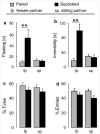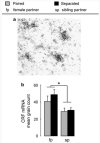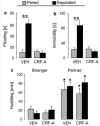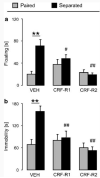The CRF system mediates increased passive stress-coping behavior following the loss of a bonded partner in a monogamous rodent
- PMID: 18923404
- PMCID: PMC2669698
- DOI: 10.1038/npp.2008.154
The CRF system mediates increased passive stress-coping behavior following the loss of a bonded partner in a monogamous rodent
Abstract
Social relationships significantly influence physiology and behavior, including the hypothalamo-pituitary-adrenal axis, anxiety, and mental health. Disruption of social bonds through separation or death often results in profound grieving, depression, and physical illness. As the monogamous prairie vole forms enduring, selective pair bonds with the mating partner, they provide an animal model to study the physiological consequences of pair bonding and, thus, the loss of the bonded partner. Male prairie voles were paired with a novel female or male sibling. After 5 days, half of the males of each group were separated from the partner. Elevated plus-maze, forced swim, and tail suspension tests were used to assess anxiety-like and passive stress-coping behaviors indicative of depressive-like behavior. Following 4 days of separation from the female but not the male partner, experimental males displayed increased passive stress-coping. This effect was abolished by long-term intracerebroventricular infusion of a nonselective corticotropin-releasing factor (CRF) receptor antagonist without disrupting the bond itself. Both CRF type 1 and 2 receptors were involved in the emergence of passive stress-coping behavior. Furthermore, pairing with a female was associated with elevated CRF mRNA in the bed nucleus of the stria terminalis, and partner loss elicited a pronounced increase in circulating corticosteroid and adrenal weight. We speculate that the CRF system may mediate an aversive affect following separation from the female partner, which may facilitate proximity seeking between the pair-bonded individuals. Hence, the prairie vole model may provide insights into brain mechanisms involved in the psychopathological consequences of partner loss.
Figures






References
-
- Aguilera G. Regulation of pituitary ACTH secretion during chronic stress. Front Neuroendocrinol. 1994;15:321–350. - PubMed
-
- Aguilera G, Rabadan-Diehl C. Vasopressinergic regulation of the hypothalamic–pituitary–adrenal axis: implications for stress adaptation. Regul Pept. 2000;96:23–29. - PubMed
-
- Aragona BJ, Liu Y, Yu YJ, Curtis JT, Detwiler JM, Insel TR, et al. Nucleus accumbens dopamine differentially mediates the formation and maintenance of monogamous pair bonds. Nat Neurosci. 2006;9:133–139. - PubMed
Publication types
MeSH terms
Substances
Grants and funding
LinkOut - more resources
Full Text Sources
Medical
Research Materials

